Dr. Shirin Melikova – Director of the Azerbaijan National Carpet Museum / President of ICOM Azerbaijan National Committee
The Azerbaijan National Carpet Museum, the first museum in the world of its kind was founded in 1967 and located in different buildings for 54 years.
In 2014, the Carpet Museum moved to a new specially designed building in order to present to the world, fully and at the proper level, the richest collection of decorative-applied art and, above all, the most complete and valuable collection of Azerbaijani carpets and carpet products.
The Azerbaijan National Carpet Museum in Baku
The museum’s new building was designed by the Austrian architect Franz Janz and built on the territory of Seaside Park. The building’s avant-garde composition in the shape of an unfolding carpet is made of metal and glass — a very bold decision for a museum that presents traditional art. The building is itself an art object and attracts attention with its architectural design.
At first glance, there is no doubt that it relates to the carpet theme. The construction’s dynamic shape, creating the effect of a coil, gives a sense of monumentality and at the same time a feeling of lightness, as if floating in air. One part imitates the fringe of the carpet and creates a dynamic three-step line on the façade of one side. From this perspective, the “flying carpet” seems as if it will unfold to cover the entire boulevard.
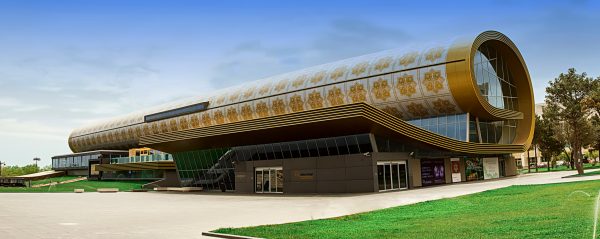
The exposition is arranged so that carpets gradually unfold in front of the viewer; going further into this enchanting space, the play of light and shadow gives birth to associations, provokes unexpected discoveries, and helps us discern the intricacies of patterns. And then this fairy-tale world, populated by fantastic animals, paradisiacal birds, and archaic symbols, comes to life and passes from the surface of the carpet through the walls and ceiling. It seems as if you are inside a huge magic carpet that takes you to another dimension and reveals all the riddles of an art that has absorbed people’s distinctive spiritual world for generations.
Along with the emotional and figurative drama inherent in both the carpets and the museum’s architecture, the exhibition builds a consistent story about the development of carpet weaving, starting with the simplest technologies. The exposition, deployed along the entire length of the building, gives an opportunity to see clearly each phase of this art’s development, to trace how the mastery of compositions’ formation was perfected, the ornamental motifs were enriched, and how the color range became more complex.

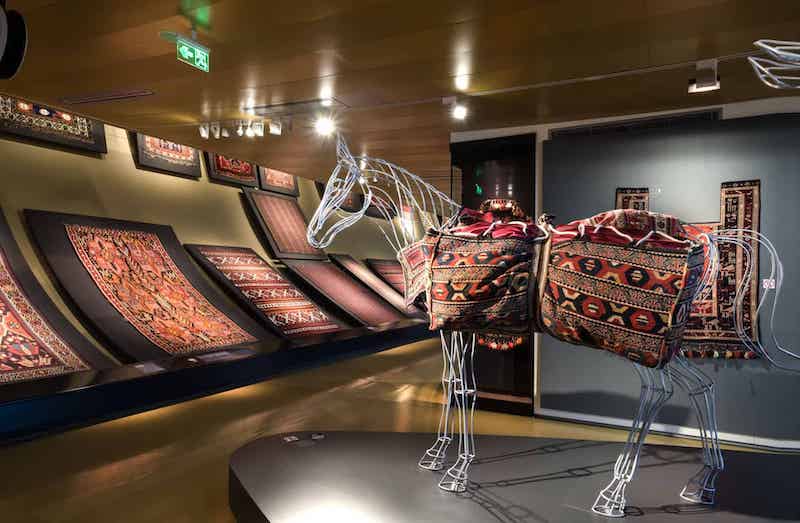
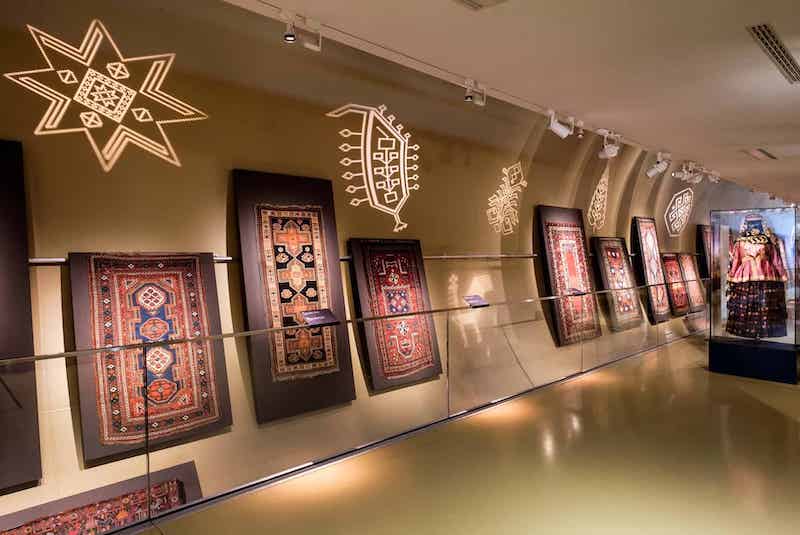
The permanent exhibition’s first floor demonstrates the stages of carpet weaving’s evolution through flat-woven techniques, showing the role of carpet and carpet products in the daily life and traditions of the Azerbaijani people.
Here one can see the exhibits found during archaeological excavations in the territory of Azerbaijan that testify to the ancient roots of this craft: needles, spinning tools, ceramics with traces of ornaments that were also widely used on carpets, and gravestones with the image of a loom and weaving tools, among other items. We also reveal all the stages of a carpet’s creation — from the shearing of sheep to the finished product — and the natural dyes, which give carpets their special beauty by saturating them with bright and intense color combinations.
The information is multilevel. Multimedia displays, shown on the built-in evolution line on the podium, represent the technique of interweaving; separate displays explain the use of carpets and carpet products in the life of semi-nomadic cattle-breeding tribes, and the role of carpets in wedding traditions.

The second floor shows all the carpet weaving regions. It houses a rich exposition of pile carpets, covering the 17th to early 20th centuries. Along with the carpets, it exhibits national costumes, products decorated with different types of embroidery, and an excellent collection of metal. There is a reconstruction of a typical Shusha room of the past centuries. The museum has recreated the charming atmosphere of a rich house where carpet plays a key role in decorating the interior. Houses in Shusha were large, and all their interiors were entirely covered with Dast Khali Gaba, consisting of three or five carpets.

Carpets adorned the walls, and the décor of ceilings repeated their compositions; the walls were painted with frescoes depicting the Garden of Paradise, and the windows were made of wooden frames with a binding in the form of the geometric ornament girih, into which colored glass was inserted. The generous use of curtains for niches, shelves, fireplaces, and other small surfaces decorated with embroideries created the sense of being in the Garden of Paradise. All the furniture formed a distinctive habitat wherein each element supported the concept of ideal beauty, capable of bringing the person’s soul closer to God, to the Absolute. In a special showcase on the same floor, we present the collection’s oldest carpet: the 17th-century Ajdahali (Dragon) carpet of Karabakh. The carpet was bequeathed to the museum by Grover Schiltz, a member of the Chicago Oriental Rug and Textile Society (USA) and was transferred by his wife Beverly Schiltz in 2013.
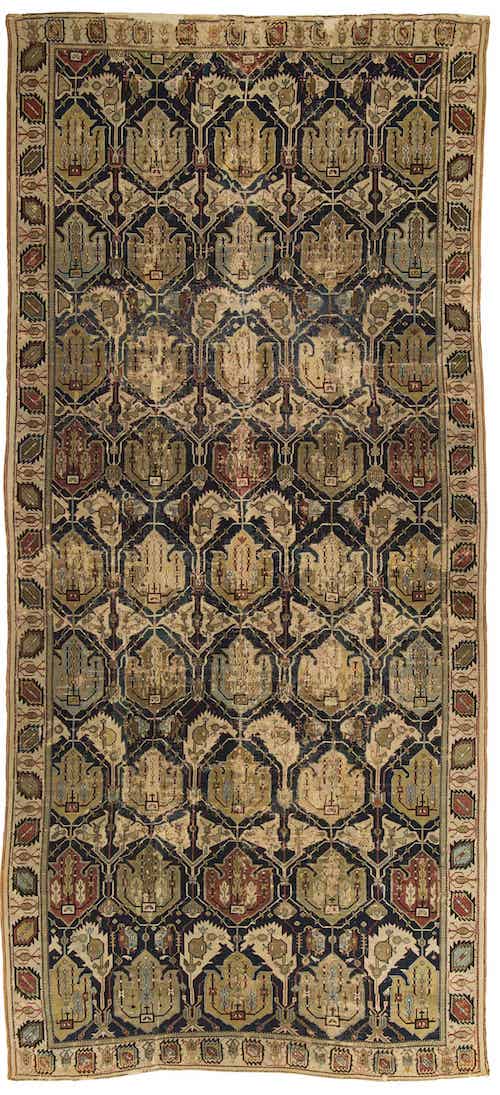

Since 2016, the ANCM has begun to seriously engage in the replenishment of the collection with ancient samples, establishing contacts with both collectors and auction houses. In 2017, the museum managed to purchase a very rare late-17th-century palace carpet Shamakhi of Shirvan at the Austria Auction Company that was miraculously preserved in one piece.
Carpets of this type have survived to our time, as a rule, in a fragmentary state. There are very few of them in the world, and they are mostly found in large museum collections. So, this carpet preserved in one piece is a great rarity. In 2018, we found a carpet with the famous Khatai (Dragon) composition in a private collection. Its complex composition, imbued with the spirit of the palace carpets of the Safavid era, includes stylized vegetative and zoomorphic ornaments typical for the carpets of the Karabakh group.
The classic version of the Khatai composition represents the intersecting notched branches creating the traditional Bandi-Rumi composition, connected by images of palmettes, a symbol of eternal life that flanked by dragons as guardians of this eternal life. The peculiarity of this carpet is that here the image of the dragon is replaced by the tree of life. Another interesting carpet from the museum’s collection is the late 17th – early 18th-century Karabakh carpet. This is a floral carpet with the Chelebi medallion, which is also of great value for studying its composition and genesis.
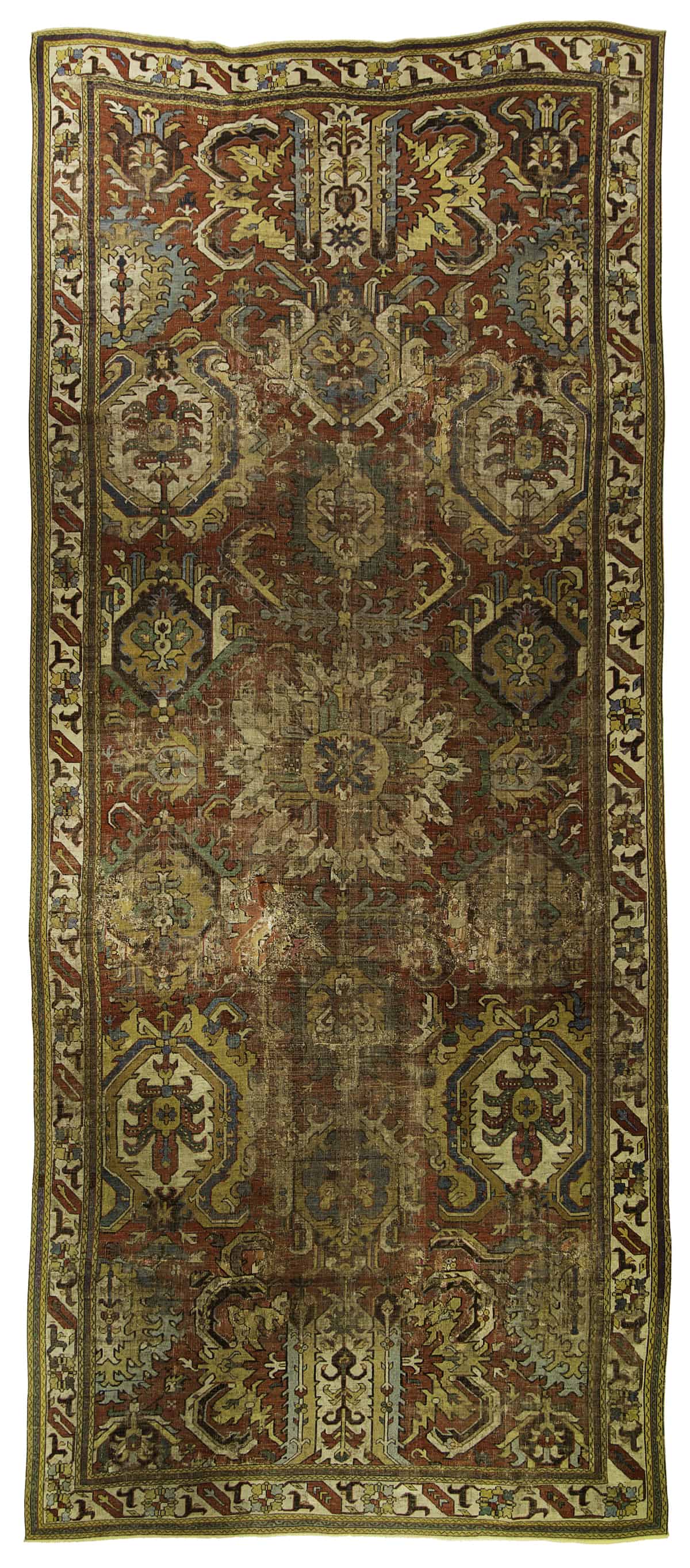
Carpet Nakhchivan. Karabakh group, Azerbaijan. Late 17th century. Azerbaijan National Carpet Museum collection. Photo: Azerbaijan National Carpet Museum
The late 17th – early 18th-century Nakhchivan carpet of Karabakh group is another precious example displayed within the museum’s permanent exhibition. These carpets have been considered the best examples of Azerbaijani carpet weaving art since antiquity. The carpet’s central field is decorated with an abstract-shaped Chelebi medallion and large palmette elements. The carpet’s large size, its skillfully woven design, and harmony of colors prove that it was performed in the workshops by special order. Such carpets were used in the 14th – 16th-centuries palaces and residences.
The permanent exhibition’s third floor introduces the development of carpet weaving in the 20th – 21st centuries. Most of the exhibits on this floor are devoted to the creativity of professional carpet artists, thanks to whom this art advanced to new levels in the 20th and early 21st centuries. Among them, first of all, we must celebrate Latif Karimov, an outstanding carpet artist, the founder of the science of carpet art, the founder of the Carpet Museum, the People’s Artist, and Laureate of the State Prize.
His research, drawings and sketches, and his own compositions are widely represented here. In addition, we highlight the life and work of the People’s Artist Kamil Aliyev, who invaluably contributed to carpet art’s evolution. The museum exposition also displays modern carpets by professional artists who worked in the 20thcentury and continue to create today.
The museum uses multimedia technologies widely. Each floor provides information that facilitates a more detailed acquaintance with the museum collection and individual exhibits via stands, touch screens, and monitors.
The Azerbaijan National Carpet Museum today prevails as Azerbaijan’s leading museum. Like all prominent museums around the world, the ANCM actively develops educational programs, conducts tours, gives lectures, and organizes masterclasses focused on its permanent collection. These interactions with visitors concentrate primarily on the diversity of technological and artistic features of our foremost national heritage: Azerbaijani carpet. The museum has become a living and ever-changing educational center for all, without exception, including visitors with disabilities. Here one can often observe visitors in wheelchairs, who easily and independently navigate our spaces. The museum’s entire exposition, explications, and captions are arranged so that one can read them effortlessly and use touchscreens while sitting.
The specificity of the ANCM means that both vision and touch give people a genuinely complete impression of carpet art. There is an entire department in the museum devoted to the preservation of traditional technologies, which weaves small carpet samples. These samples accompany the whole permanent exhibition. Such an interactive and tactile display is necessary for a detailed understanding of our collection’s specifics, and it engages visitors of all ages. Significantly, this innovation makes it possible for individuals who are visually impaired or blind to “see” our carpets, experience a variety of techniques, and feel the ornaments’ shapes. Braille and audio recordings also provide detailed information about each exhibit.



















